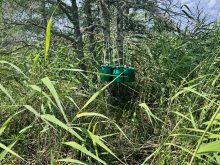As calving season approaches, producers should keep one thing in mind – do most of the work before and after calving, not during the birth process.
“The best thing for most guys to do is stay away. Let Mother Nature do her thing,” said Alberta Agriculture beef specialist Jim Hansen.
If the cow is making no progress after an hour or appears to have given up, it may be time to jump in. If the calf’s legs and nose are sticking out but no headway has been made, intervene after about half an hour.
Read Also

Research looks to control flea beetles with RNAi
A Vancouver agri-tech company wants to give canola growers another weapon in the never-ending battle against flea beetles.
Producers often ask Hansen what they should do once they’ve rolled up their sleeves and nothing is happening. When is it time to call the veterinarian?
If the chains are on the calf, the mechanical puller is jacked back and the farmer is pushing down on the puller but nothing is happening, that calf is likely a cesarean section candidate, said Hansen.
The most important thing a producer can do before calving is ensure the cow is properly nourished.
“If the cow is in good shape, it takes care of a lot of the problems that sometimes come up.”
The cow’s body condition score should be between 2.5 and three on the Canadian scale or at five on the American scale. Six weeks before calving, the mother should receive adequate levels of minerals and healthy doses of vitamins A and E.
Hansen, who works out of Alberta Agriculture’s Cardston, Alta., office, said researchers have discovered that vitamin E dramatically improves a cow’s immune system and the quality of colostrum it produces. Producers should have back-up supplies of colostrum in case a calf is unable to suckle from its natural mother. It is crucial that a calf receive colostrum in the first two or three hours of its life.
Colostrum reserves come from cows that have lost calves or are producing excess milk. The fluid should be stored in plastic bags kept in the freezer. The frozen milk should be thawed in warm water rather than microwaved. A visit to a neighboring dairy farm is another option, but the colostrum should ideally come from your own herd.
Cows that have been on the range may balk at being led into a barn to calve. Let the cow calve outside and allow it to bond with its offspring before leading the pair into the barn to dry the calf and warm it up.
Mom and baby should bond before the calf is weighed or ear-tagged. If a cow isn’t bonding with its calf, you may want a veterinarian to administer a tranquilizer and hobble its hind legs for one or two days so the cow doesn’t kick the calf away when it’s trying to nurse. Hansen finds the tranquilizer works like a charm.
“By the time they come back to reality they quite frequently like that calf that’s now beside them.”
Producers who want to weigh the calf after it’s born should use the piggin’ string technique. Modern slings allow the calf to wriggle around too much.
“We found the old cowboy method of tying one (front) leg to the back two and picking him up works just great.”
He encourages farmers to use generous amounts of straw for calves that have to be confined indoors and to supply adequate ventilation in calf shelters. Without proper airflow, the shelters may be warm and cozy, but they can also become a breeding ground for disease.
“We’re killing them with kindness.”
Hansen’s last tip is to group newborns according to age and keep the groups smaller than 50 animals. Throwing newborns in with three-week-old calves can cause anxiety.
“(The newborn) just feels better if he’s grouped with calves of similar age and size all doing the same kind of thing.”

















